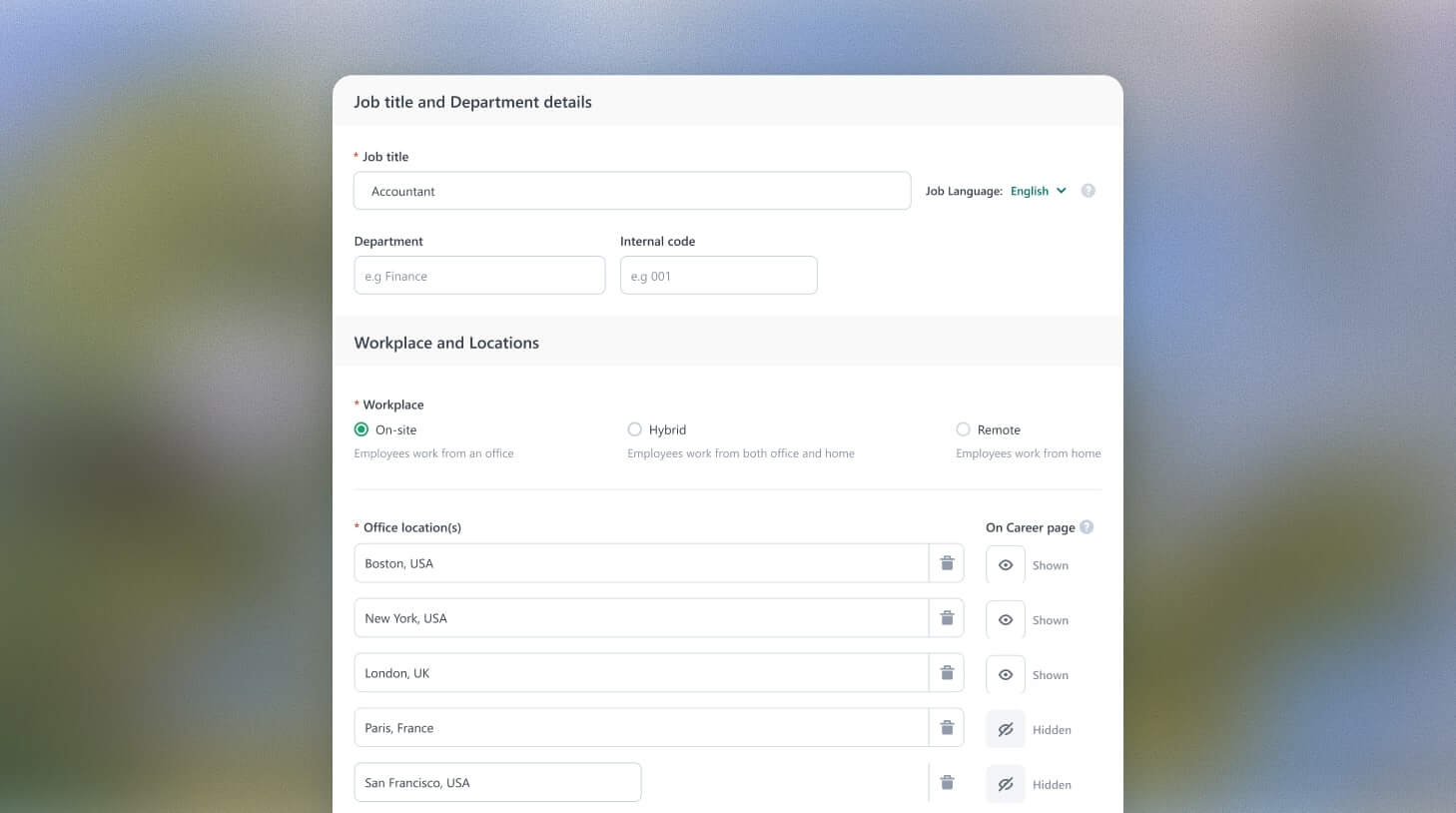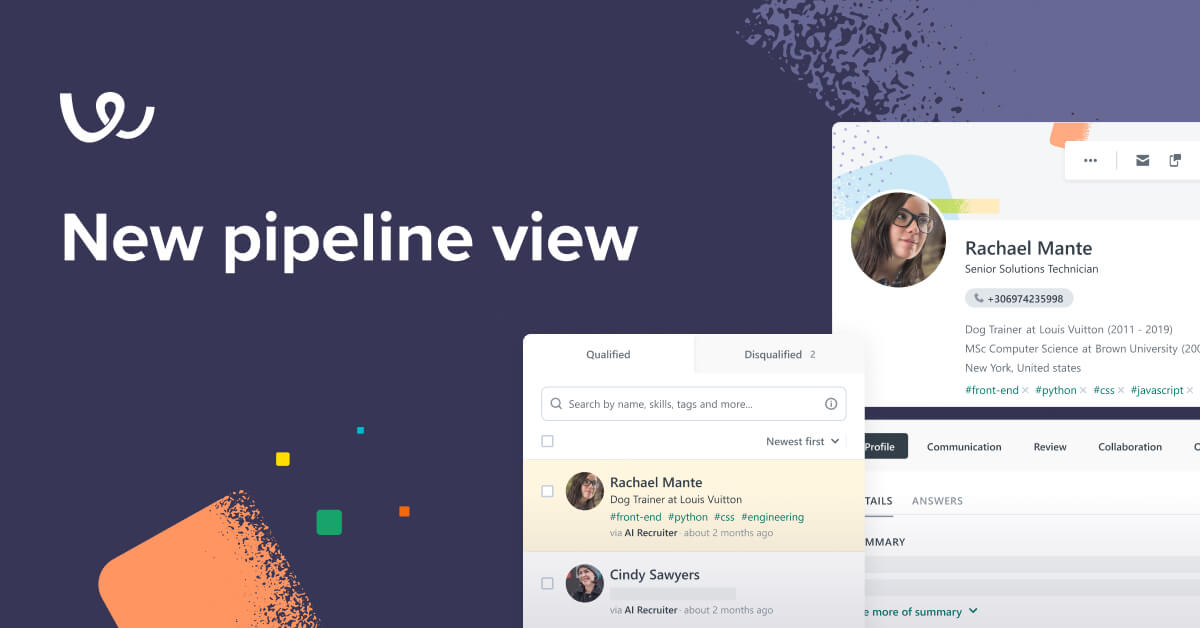The benefits of using AI applicant tracking systems
AI tracking applicant system is an advanced technology used by companies during the hiring process. It automates candidate screening, tracking, and ranking, streamlining recruitment by analyzing resumes, skills, and qualifications to identify the most suitable candidates efficiently.
Although it may seem like technology is taking over the world, hiring top talent still requires a human touch. As anyone who’s ever been on a hiring team knows, finding the right fit for an open role involves far more than simply reading some resumes to see who has adequate candidate experience. You also need to evaluate soft skills, personality traits, and whether or not an applicant would be a good cultural fit for your organization — you need to get to know who a candidate is, and not just how they work.
While it’s true that robots won’t be replacing hiring managers any time soon, the recruitment process can be time-consuming, expensive, and involves a lot of moving parts. Using artificial intelligence, such as AI applicant tracking software, to automate and streamline aspects of talent acquisition can reduce time-to-hire and increase confidence in hiring decisions by empowering HR professionals to use their time and talent more productively.
Contents
What is AI Applicant Tracking Software?
AI Applicant Tracking Software (ATS) is a type of recruitment software that uses artificial intelligence (AI) and machine learning technologies to optimize the recruitment and hiring process.
Many of the aspects of the talent acquisition process are important but time-intensive tasks that cater to the logistical steps of attracting and screening applicants. AI technology can orchestrate and manage many of these tasks efficiently and effectively, freeing up recruiters and HR professionals to oversee the entire workflow while focusing their own efforts on the areas that require human experience and insight.
What are the benefits of an AI Applicant Tracking System?
Hiring a new employee involves a ton of paperwork, scheduling, reviewing, record-keeping, and internal and external communication. Recruiters use AI-based applicant tracking systems to streamline the hiring process from start to finish, increasing productivity and reducing the likelihood of human error.
An AI applicant tracking system can function not only as a central repository of information, but also as an ever-ready human resources assistant capable of writing job descriptions, advertising job openings, reviewing job applications, performing assessments, scheduling interviews for qualified candidates and more.
Artificial intelligence also offers an unbiased source of information based on data, which can help ensure that candidates receive fair and consistent consideration. Combining the insights of AI tools with the instincts and experience of hiring managers adds scientific objectivity to the art of attracting and identifying the best candidates for a role.
AI-based ATS applications may include the following functionalities and features:
- Resume parsing: The ATS can automatically extract and parse relevant information from resumes and CVs submitted by job applicants. This makes it easier for recruiters to search and filter candidates based on specific skills, qualifications, experience, and other criteria.
- Job posting: The software enables the creation and distribution of job postings across various online platforms, job boards, and social media networks like LinkedIn. Some ATS tools can even suggest suitable job titles and keywords to optimize job descriptions to improve the visibility of job listings.
- Candidate sourcing: ATS can use AI algorithms to search for potential candidates from various sources, including online job portals, social media, and internal databases. This feature helps recruiters expand their talent pool and discover passive candidates.
- Automated screening: With AI-powered screening, the ATS can analyze and match candidates’ qualifications and experience with job requirements. This process helps in shortlisting candidates who are the best fit for the position, saving time and effort for recruiters.
- Candidate communication: ATS often includes features for automated communication with candidates, such as chatbot integrations that can be used to send acknowledgment emails, interview invitations, and rejection notifications. This ensures a smooth and professional candidate experience throughout the hiring process.
- Interview scheduling: Some ATS tools offer interview scheduling features that allow recruiters to set up interviews with candidates directly within the system, eliminating the need for back-and-forth communication.
- Performance analytics: ATS provides valuable insights and analytics on the recruitment process, such as time-to-fill, source of hire, candidate engagement, and more. This data helps HR teams make data-driven decisions to optimize their hiring strategies.
- Diversity and inclusion: Some advanced ATS platforms come with features that promote diversity and inclusion by removing bias from the hiring process. They can help identify potential biases in job descriptions and applicant data and support record-keeping for compliance purposes.
The implementation of AI in applicant tracking software significantly improves the efficiency of the recruitment process by automating repetitive tasks, enhancing candidate matching, and providing valuable data for better decision-making, allowing HR professionals to focus more on strategic aspects of talent acquisition and employee engagement.
How to choose an AI ATS
Choosing the right AI applicant tracking system is a critical decision — it directly impacts the effectiveness of the recruitment process and implementing a new workflow or system can be temporarily disruptive as stakeholders adjust to the change.
Here are some steps to help guide the selection process:
- Define your requirements: Start by identifying the specific needs of your organization. Consider factors such as the size of your company, the number of job openings you typically have, the desired features and functionalities, budget constraints, and any specific integration requirements with existing HR or recruitment tools.
- Research and compare options: Conduct thorough research to explore various AI ATS providers in the market. Look for vendors that have a good reputation, positive customer reviews, and a track record of successful implementations. Create a shortlist of ATS platforms that seem to align well with your requirements.
- Check for AI capabilities: Verify that the ATS platforms you are considering have genuine AI capabilities. Some platforms might claim to be AI-powered but have limited functionality. Look for features like resume parsing, automated candidate screening, and intelligent candidate matching.
- User-friendliness: A user-friendly interface is crucial for a smooth adoption of the ATS within your HR team. Request demos or trials of the shortlisted systems to evaluate their ease of use, navigation, and overall user experience.
- Integration options: Consider the compatibility and integration options of the ATS with your existing HR software and tools. Seamless integration can streamline data sharing and improve overall HR processes.
- Mobile accessibility: With the increasing use of mobile devices, ensure that the ATS offers a mobile-friendly interface for both recruiters and candidates. This allows for greater flexibility in managing applications on the go.
- Candidate experience: Choose a system that offers a simple and intuitive application process, clear communication, and timely feedback to applicants.
- Data security and compliance: Given the sensitive nature of candidate data, it’s essential to prioritize data security and compliance. Ensure that the ATS provider follows industry-standard security practices and complies with relevant data protection regulations.
- Customer support and training: Look for a vendor that provides excellent customer support and training resources to help your HR team maximize the benefits of the ATS.
- Scalability and future-proofing: Consider the scalability of the ATS, as your organization’s hiring needs may change over time. Additionally, inquire about the vendor’s plans for future updates and developments to ensure the system remains up-to-date with the latest technologies.
- Obtain feedback from stakeholders: Involve key stakeholders, such as other HR team members, hiring managers, and IT personnel in the decision-making process. Get their input on the features they find most valuable and any concerns they may have.
- Request references: Ask the ATS vendors for references from their existing clients. Reach out to these references to gather insights into their experiences with the system and the vendor’s customer support.
By following these steps and conducting a thorough evaluation, the Human Resources manager can make an informed decision and choose an AI applicant tracking system that best aligns with the organization’s needs and objectives.
Why use AI Applicant Tracking?
Using an AI applicant tracking system as part of the recruitment process saves time, reduces bias, facilitates collaboration, and analyzes helpful data, which makes life infinitely easier for hiring teams.
An often under-appreciated benefit is that an AI-based ATS also improves the candidate experience. AI tools make it easier to keep applicants informed throughout the process, and improved efficiency makes it clear that your organization values the time and effort of everyone involved. A positive candidate experience increases the talent pool for future roles, making it even more efficient to find and hire the right candidates for open positions in the future. As a result, incorporating AI tools into your hiring process is an investment in attracting and retaining top talent for years to come.
Overall, AI applicant tracking empowers HR professionals to be more efficient, make data-driven decisions, and improve the quality of the hiring process, ultimately leading to better hires and a stronger workforce. Artificial intelligence won’t be replacing the human resources department any time soon, but it can maximize the impact of their efforts.
Frequently asked questions
- What is AI Applicant Tracking Software?
- It's a recruitment software that uses AI and machine learning to streamline the hiring process, automating many time-consuming tasks.
- Can AI Applicant Tracking Systems help reduce bias?
- Yes, these systems offer an unbiased source of information based on data, promoting fair and consistent candidate consideration.
- How does AI ATS enhance the candidate experience?
- It offers timely feedback, clear communication, and a simple application process, ensuring a smooth and professional candidate journey.
- Does AI Applicant Tracking Software replace human recruiters?
- No, it enhances their work by automating repetitive tasks, freeing them to focus on strategic aspects of talent acquisition.
- What are some key features of an AI ATS?
- Resume parsing, automated candidate screening, job posting, candidate communication, interview scheduling, performance analytics, and promoting diversity are key features.




